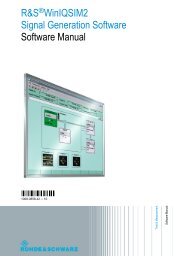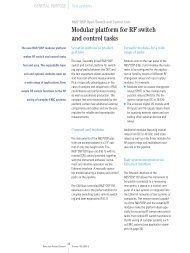News from Rohde&Schwarz - Rohde & Schwarz
News from Rohde&Schwarz - Rohde & Schwarz
News from Rohde&Schwarz - Rohde & Schwarz
You also want an ePaper? Increase the reach of your titles
YUMPU automatically turns print PDFs into web optimized ePapers that Google loves.
Panorama<br />
3G test scenario in research and development<br />
Third-generation mobile radio –<br />
universal test concepts pave the way<br />
The world of mobile radiocommunication is undergoing dramatic changes as<br />
far as technology, services and type approval test regulations are concerned:<br />
the third mobile radio generation (3G) is on its way (FIG 1). Pioneering measurement<br />
technology has to come up with solutions for increasingly complex<br />
test requirements at an early stage and should be instrumental in launching the<br />
new generation on the road to success. <strong>Rohde</strong> & <strong>Schwarz</strong>, the world's market<br />
leader in the field of mobile radio test technology, takes up this enormous challenge<br />
with a flexible and<br />
future-oriented test<br />
concept.<br />
FIG 1<br />
While today’s mobile phones are mostly used<br />
for voice communication, those of the third<br />
generation (3G) will open up the entire<br />
multimedia spectrum<br />
Photo 43 360<br />
2G – 2.5G – 3G:<br />
mobile radiocommunication<br />
moves on unabated<br />
The introduction of high-speed data<br />
services (HSCSD) and packet-oriented<br />
transmission methods (GPRS) for the<br />
second mobile radio generation (2G)<br />
is currently the first step towards new<br />
applications using high data rates<br />
(2.5G technology). Test platforms <strong>from</strong><br />
<strong>Rohde</strong> & <strong>Schwarz</strong> are well prepared<br />
for this transition [1], [2].<br />
At the same time the next mobile radio<br />
generation based on W-CDMA (3G)<br />
is on its way. Its standardization is<br />
making rapid progress within the<br />
framework of<br />
the international<br />
3GPP (3rd generation partnership<br />
project) body. Signal generators<br />
and analyzers <strong>from</strong> <strong>Rohde</strong> &<br />
<strong>Schwarz</strong> have set standards in this<br />
field <strong>from</strong> the very beginning [3], [4],<br />
[5]. There is also a growing demand<br />
for more complex test systems as 3G<br />
activities progress beyond the research<br />
stage and turn into ambitious development<br />
projects. Requirements go far<br />
beyond mere RF measurements at the<br />
air interface or signalling tests at layers<br />
1 to 3. Testing overlaid applications<br />
at a higher protocol level ( layer 3) is<br />
gaining in importance.<br />
FIG 2 gives an overview of the emerging<br />
scenario. While today’s mobile<br />
phones are mostly used as terminals<br />
for voice communication, mobiles of<br />
the third generation will open up the<br />
entire multimedia spectrum <strong>from</strong> voice<br />
telephony through video applications<br />
to data services based on the Internet<br />
protocol (IP) and integrated by the<br />
wireless application protocol (WAP).<br />
It is conceivable that dedicated terminals<br />
like personal digital assistants<br />
(PDA) will provide access to the different<br />
services, so that a mobile acts like<br />
a mobile switching station. Transmission<br />
in the local area between the terminal<br />
and the mobile station will be<br />
based on standards optimized for this<br />
<strong>News</strong> <strong>from</strong> <strong>Rohde</strong> & <strong>Schwarz</strong> Number 164 (1999/IV) 29

















